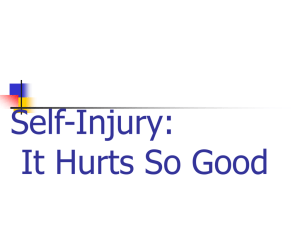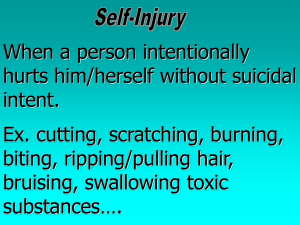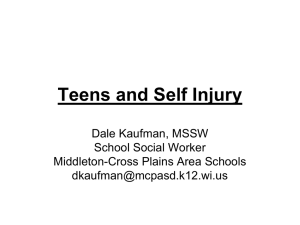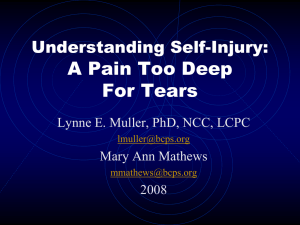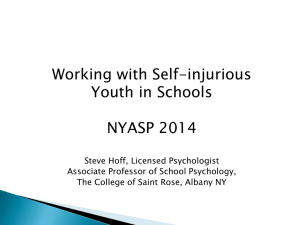trol it, have beenrepeatedly documented in the 15 years has focused
advertisement
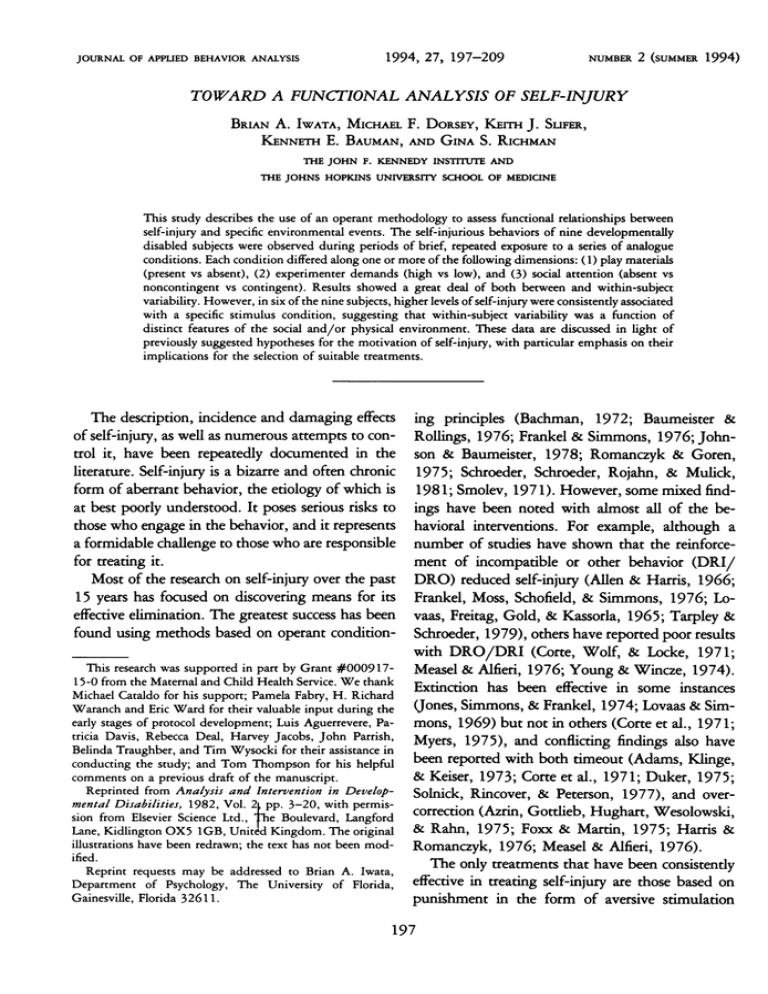
JOURNAL OF APPLIED BEHAVIOR ANALYSIS
1994227,197-209
NUMBEP.
2
(summER 1994)
TOWARD A FUNCTIONAL ANALYSIS OF SELF-INJURY
BRIAN A. IWATA, MICHAEL F. DORSEY, KEITH J. SUIFER,
KENNETH E. BAUMAN, AND GINA S. RICHMAN
THE JOHN F. KENNEDY INSTITUTE AND
THE JOHNS HOPKINS UNIVERSITY SCHOOL OF MEDICINE
This study describes the use of an operant methodology to assess functional relationships between
self-injury and specific environmental events. The self-injurious behaviors of nine developmentally
disabled subjects were observed during periods of brief, repeated exposure to a series of analogue
conditions. Each condition differed along one or more of the following dimensions: (1) play materials
(present vs absent), (2) experimenter demands (high vs low), and (3) social attention (absent vs
noncontingent vs contingent). Results showed a great deal of both between and within-subject
variability. However, in six of the nine subjects, higher levels of self-injury were consistently associated
with a specific stimulus condition, suggesting that within-subject variability was a function of
distinct features of the social and/or physical environment. These data are discussed in light of
previously suggested hypotheses for the motivation of self-injury, with particular emphasis on their
implications for the selection of suitable treatments.
The description, incidence and damaging effects
of self-injury, as well as numerous attempts to control it, have been repeatedly documented in the
literature. Self-injury is a bizarre and often chronic
form of aberrant behavior, the etiology of which is
at best poorly understood. It poses serious risks to
those who engage in the behavior, and it represents
a formidable challenge to those who are responsible
for treating it.
Most of the research on self-injury over the past
15 years has focused on discovering means for its
effective elimination. The greatest success has been
found using methods based on operant conditionThis research was supported in part by Grant #00091715-0 from the Maternal and Child Health Service. We thank
Michael Cataldo for his support; Pamela Fabry, H. Richard
Waranch and Eric Ward for their valuable input during the
early stages of protocol development; Luis Aguerrevere, Patricia Davis, Rebecca Deal, Harvey Jacobs, John Parrish,
Belinda Traughber, and Tim Wysocki for their assistance in
conducting the study; and Tom Thompson for his helpful
comments on a previous draft of the manuscript.
Reprinted from Analysis and Intervention in Developmental Disabilities, 1982, Vol. 2 pp. 3-20, with permission from Elsevier Science Ltd., "rhe Boulevard, Langford
Lane, Kidlington OX5 1GB, United Kingdom. The original
illustrations have been redrawn; the text has not been modified.
Reprint requests may be addressed to Brian A. Iwata,
Department of Psychology, The University of Florida,
Gainesville, Florida 32611.
ing principles (Bachman, 1972; Baumeister &
Rollings, 1976; Frankel & Simmons, 1976; Johnson & Baumeister, 1978; Romanczyk & Goren,
1975; Schroeder, Schroeder, Rojahn, & Mulick,
1981; Smolev, 1971). However, some mixed findings have been noted with almost all of the behavioral interventions. For example, although a
number of studies have shown that the reinforcement of incompatible or other behavior (DRI/
DRO) reduced self-injury (Allen & Harris, 1966;
Frankel, Moss, Schofield, & Simmons, 1976; Lovaas, Freitag, Gold, & Kassorla, 1965; Tarpley &
Schroeder, 1979), others have reported poor results
with DRO/DRI (Corte, Wolf, & Locke, 1971;
Measel & Alfieri, 1976; Young & Wincze, 1974).
Extinction has been effective in some instances
(Jones, Simmons, & Frankel, 1974; Lovaas & Simmons, 1969) but not in others (Corte et al., 1971;
Myers, 1975), and conflicting findings also have
been reported with both timeout (Adams, Klinge,
& Keiser, 1973; Corte et al., 1971; Duker, 1975;
Solnick, Rincover, & Peterson, 1977), and overcorrection (Azrin, Gottlieb, Hughart, Wesolowski,
& Rahn, 1975; Foxx & Martin, 1975; Harris &
Romanczyk, 1976; Measel & Alfieri, 1976).
The only treatments that have been consistently
effective in treating self-injury are those based on
punishment in the form of aversive stimulation
197
198
BRIAN A. IWATA et al.
(Birnbrauer, 1968; Corte et al., 1971; Dorsey,
Iwata, Ong, & McSween, 1980; Sajwaj, Libet, &
Agras, 1974; Tanner & Zeiler, 1975). However,
due to concerns regarding the appropriate and safe
use of "restrictive" or "intrusive" treatments (e.g.,
ACFMR, 1971), it has been recommended that
punishment be limited to those situations in which
other interventions have failed (May, Risley, Twardosz, Friedman, Bijou, Wexler et al., 1975). It is
therefore important to conduct research that may
eventually identify the limiting conditions of the
various treatments for self-injury. It would be especially useful if these conditions were known prior
to initiating what otherwise might be an arbitrarily
determined and seemingly endless series of interventions.
Recent reviews (Carr, 1977; Johnson & Baumeister, 1978) have suggested that some of the
treatment failures and inconsistencies reported
throughout the literature may reflect a lack of understanding regarding the variables that either produce or maintain self-injury. In discussing a number
of hypotheses for the motivation of self-injury, Carr
(1977) indicated that the behavior may be reinforced through extrinsic sources (e.g., through positive reinforcement such as attention, or negative
reinforcement such as the termination of demands),
or that the behavior itself may produce some form
of intrinsic reinforcement (e.g., sensory stimulation,
pain reduction). This conceptualization of self-injury as a multiply controlled operant would indicate
that no single form of treatment can be expected
to produce consistent positive results, and it suggests that one means of selecting a potentially effective treatment would consist of first determining
what events are currently maintaining the behavior.I
I
Punishment would be an exceptional case because its
effectiveness does not depend on its ability to alter a reinforcement contingency. Rather, punishment is effective due
to the fact that its "aversive" properties are sufficient to
overcome whatever source of reinforcement is maintaining
the behavior (Azrin & Holz, 1966). Given the types of
stimuli that typically have been used as punishing events
(e.g., electric shock, aromatic ammonia), it is not surprising
to find that punishment has been found to be the most
effective treatment for self-injury.
For several reasons, very little behavioral research
has focused on the environmental determinants of
self-injury. First, in light of data from numerous
sources suggesting that self-injury is a learned phenomenon, behavioral researchers and clinicians generally have dismissed the importance of etiology,
since the conditions that are necessary to develop
or maintain a response may be totally unrelated to
the conditions that are sufficient to alter or eliminate
it. Second, with respect to the initial development
of self-injury, functional analyses have been limited
to animal studies (Holz & Azrin, 1961; Schaeffer,
1970), since experimental attempts to induce selfinjury in humans when it does not already exist
would be regarded as unacceptable from the standpoint of subject risk/benefit. Third, the apparent
severity of the behavior often suggests the need for
immediate attention, thereby discouraging attempts to identify features of the social and physical
environment that may serve to maintain self-injury
(see Carr, Newsom, & Binkoff, 1976, for a notable
exception).
Over the past two years, we have been working
toward the development and refinement of an operant methodology whose application might prove
useful in identifying the functional properties of
self-injury on a pretreatment basis. This article describes and presents the results obtained with our
initial assessment protocol, in which subjects' behavior was repeatedly observed across several welldefined analogue environments. Similar approaches
have been used to examine the effects of physical
aspects of the environment on behaviors such as
stereotypy (Adams, Tallon, & Stangl, 1980) and
pica (Madden, Russo, & Cataldo, 1980). In the
present study, environmental events consisted of
both physical and social manipulations that might
differentially affect the occurrence of self-injury.
METHOD
Subjects and Setting
Nine subjects participated in the study. All
showed some degree of developmental delay, and
were admitted for inpatient evaluation and/or
treatment to The John F. Kennedy Institute, a
199
FUNCTIONAL ANALYSIS OF SELF-INJURY
Table 1
Demographic Characteristics of Subjects
Sub-
Age in Developmental
level
years
ject
Sex
I
F
46/12
2
M
510/12 8-12 mo
3
M
4
M
68/12
5
M
131/12
2-3 yr
6
M
17/l2
6-9 mo
7
M
172/12
15-24 mo
8
M
49/12
2-14 mo
9
M
37/12 6-12 mo
13
2-3/, yr
8-10 mo
10-15 mo
Motor
involvement
Diagnosis
Mild to moderate mental retardation
Spastic cerebral palsy, Congenital rubella syndrome,
profound mental retardadelayed
tion, blind, hearing deficit
Normal (restricted by Profound mental retardation,
Down's syndrome
arm restraints)
Profound mental retardation,
Normal
autistic-like behavior
Poor ambulation, ab- Severe to profound mental
retardation, Rubensteinnormal gait, delayed
Taybi syndrome
Developmental delay, craDelayed
niosynostosis
Mild cerebral palsy, de- Congenital rubella syndrome,
profound mental retardalayed
tion
Profound mental retardation,
Delayed
Down's syndrome
Profound mental retardation
Cerebral palsy, left
hemiplegia, delayed
Normal
pediatric hospital affiliated with TheJohns Hopkins
University School of Medicine. Interviews and direct observations conducted prior to admission indicated that each subject exhibited moderate to high
rates of self-injurious behavior. Demographic information for each subject is provided in Table 1.
Sessions were conducted in 3.Om by 3.Om therapy
rooms, equipped with tables and chairs, a variety
of games and toys, and either floor carpeting or a
mat. Each therapy room was adjoined to a 3.Om
by 1.5m observation room via a one-way mirror.
Human Subjects Protection
In order to assess the differential effects of en-
vironment on self-injury, the present study required
that subjects be allowed to engage in self-injurious
behavior while free from mechanical, physical or
chemical restraint. All procedures were reviewed
and approved by a human subjects committee, and
the following safeguards were employed to reduce
the risk of physical damage as a function of selfinjury exhibited during the observation sessions.
First, each subject received a complete medical ex-
Self-injury
Self-biting, head banging
Eye gouging, head banging
Ear pulling, head banging
Head banging, head hitting
Face slapping, head banging,
hand biting
Hand mouthing
Head hitting, head banging,
arm biting, self-choking,
hair pulling
Head hitting, head banging
Head hitting, head banging
amination by a physician, as well as other diagnostic
consultations (e.g., neurological, audiological, visual). The purpose of the examination was to assess
current physical status and to rule out organic factors that might be associated with or exacerbated
by self-injury. Potential subjects who presented an
immediate risk of severe physical damage due to
self-injury were not induded in the study. Second,
each subject's physician recommended a criterion
(expressed in terms of either degree of injury or
level of responding or both) for terminating observation sessions due to physical risk. Physicians
and nurses observed sessions intermittently in order
to assess subjects' self-injury as it occurred and, if
necessary, to modify the criterion. Third, if a subject's physical condition or level of responding met
the criterion for terminating a session, (s)he was
removed from the therapy room, self-injury was
interrupted via brief physical or mechanical restraint, and a physician or nurse examined the subject and either approved continuation or recommended postponement of the sessions. Fourth,
following each set of four observation sessions, sub-
BRIAN A. IWATA et al.
200
Table 2
Observer Definitions of Subjects' Self-injury
Definition
Response
Ear pulling & gouging
Eye gouging
Face slapping
Hair pulling
Handmouthing
Head banging
Head hitting
Neck choking
Self-biting
Closure of fingers, fingernails or hand on ear with a pulling or digging motion
Any contact of any part of hand within the ocular area
Forecful contact of the open hand with the face
Closure of the fingers and thumb on hair with a pulling
motion away from the head
Insertion of one or more fingers into the mouth
Forceful contact of the head with a stationary environmental object
Forceful contact of the hand with any part of the head
Forceful dosure of both hands around the neck
Closure of the upper and lower teeth on the flesh of any
portion of the body
jects were routinely examined by a nurse who noted
any changes in physical status as a result of selfinjury. Finally, each subject's case was reviewed at
least weekly in both departmental case conferences
and interdisciplinary rounds.
In light of the above procedures, it was felt that
the degree of risk to which subjects were exposed
was no greater (and perhaps considerably less) than
that found in their natural environment. During
the course of the study, subjects often engaged in
self-injury to the extent that minor bleeding or
swelling occurred; however, at no time did subjects
require any medical care due to their self-injury
other than routine deaning and/or topical dressing
by a nurse. On three occasions, a session was terminated prematurely for subject 7, due to an extremely high rate of forceful head banging against
the floor of the observation room. However, selfinjury was never severe enough to require the termination of a session for other subjects, and no
subject was ever exciuded from participation in
sessions due to residual effects of accumulated self-
injury.
Response Definitions and Measurement
Observations conducted prior to and upon admission indicated that all subjects engaged in two
or more self-injurious topographies, with head
banging the most prevalent. Table 2 contains a
Subjects
3
2
6
7
6
1-9
4, 5, 7, 9
7
1, 5, 7
listing of the specific self-injurious responses observed for each subject, along with operational definitions used in collecting data.
During each session, an observer recorded the
occurrence or nonoccurrence of self-injurious behavior from the observation room during continuous, 10-sec intervals (Powell, Martindale, & Kulp,
1975). Interval changeovers were signalled by a
cassette tape containing pre-recorded prompts. The
dependent variable of interest consisted of the percentage of intervals during which one or more selfinjurious responses were scored, and was calculated
by dividing the number of positively scored intervals by the total number of intervals, and multiplying by 100.
Interobserver Agreement
Two observers independently scored responses
during 35% of the sessions (the range for individuals was 17% to 67%). Overall, occurrence, and
nonoccurrence reliability percentages were calculated on an interval-by-interval basis by dividing the
number of agreements by the number of agreements plus disagreements, and multiplying by 100
(Bailey & Bostow, 1979; Hawkins & Dotson,
1975). Overall, occurrence, and nonoccurrence
agreement averaged 96.8%, 82.8%, and 91.7%,
respectively. Individual means and ranges for each
subject are presented in Table 3. Lower agreement
FUNCTIONAL ANALYSIS OF SELF-INJURY
201
Table 3
Interobserver Agreement Data
Percent of
observations
for which
observer
Nonoccurrence
Occurrence
Overall
agreement
Subject was measured
1
2
3
4
5
26.6
67.0
6
32.0
17.0
25.0
17.0
7
8
9
45.0
30.3
61.3
X%
Range
X%
Range
X%
Range
99.8
88.0
98.8
98-100
63-100
88-100
94-99
97-100
100
73-100
91-100
96-100
84.3
80.4
95.0
86.8
93.5
100
72.9
85.5
46.9
50-100
41-100
75-100
78-95
75-100
100
21-100
43-100
0-100
99.7
63.2
97.8
80.0
99.3
100
88.8
97.5
99.0
97-100
27-100
83-100
39-99
98-100
100
61-100
90-100
95-100
96.3
99.7
100
92.4
97.0
99.2
percentages were obtained during sessions in which sign that used a multielement manipulation (Barsubjects exhibited either extremely high or extreme- low & Hayes, 1979; Sidman, 1960; Ulman &
Sulzer-Azaroff, 1975). Subject 1, who served as a
ly low levels of responding.
pilot, was exposed to three of the four conditions.
Staff Training
Eight sessions (two per condition) were conducted
All observers and experimenters who participat- each day, with four sessions occurring in the morned in the study had previous coursework and ex- ing and four in the afternoon. The order of preperience in the use of behavioral interventions with sentation for each series of four sessions was deterdevelopmentally disabled children. In addition, mined by random drawing. Each session lasted for
specific training activities were employed to ensure 15 min, with the exception of the three occasions
that staff could reliably observe behavior and re- noted earlier. For those conditions requiring the
spond appropriately during sessions in which they presence of an experimenter in the room with a
served as an experimenter. Each staff member re- subject, at least three different persons were trained
ceived written instructions describing the observa- to conduct sessions for each subject, and were rotion procedure and experimental protocol. After tated to control for experimenter-specific effects.
reading and reviewing these materials with an ex- Within each series of conditions, experimenters were
perienced staff member, a new staff member was changed between sessions, and subjects were briefly
assigned to conduct informal observations, reli- removed from the room.
Social disapproval. The experimenter and subability observations, and primary data observations
for approximately five sessions each. Persons serving ject entered the therapy room together, where a
as experimenters (i.e., those conducting sessions) variety of toys were available on a table and the
did so only after demonstrating competence as an floor, within easy reach of the subject. The experobserver. At least one of the authors was present imenter directed the subject to "play with the toys"
during each session and provided feedback regard- while the experimenter "does some work." If the
subject had questionable receptive language or poor
ing compliance with the procedures as needed.
hearing, the experimenter initially placed the subExperimental Conditions
ject in physical contact with the toys. The experiEight of the nine subjects were exposed to each menter then sat in a chair across the room and
of four different conditions in an experimental de- assumed the appearance of reading a book or mag-
202
BRIAN A. IWATA et al.
azine. Attention was given to the subject contingent
upon each episode of self-injury (either a single
response or a rapid burst of responses), and took
the form of statements of concern and disapproval
(e.g., "Don't do that, you're going to hurt yourself'; "Look at your hand, don't hit yourself';
etc.), paired with brief physical contact of a nonpunitive nature (e.g., hand on shoulder). All other
responses exhibited by the subject were ignored.
This condition was designed to approximate one
type of reinforcement contingency that might maintain self-injury. In the natural environment, especially in institutional settings having low staffto-client ratios, self-injury often produces much
emotional behavior and attention from caregivers,
while other behavior receives relatively little attention (Frankel & Simmons, 1976; Lovaas et al.,
1965; Lovaas & Simmons, 1969; Risley, 1968).
Thus, statements of concern and social disapproval
paired with physical contact contingent upon selfinjury may maintain the behavior via inadvertent
delivery of positive reinforcement.
Academic demand. Educational activities appropriate for each subject were selected on the basis
of a special education evaluation conducted upon
admission, or from an individual education program plan obtained from the subject's current school
or institutional placement. Examples of the educational tasks included: placing plastic rings on a
peg, stacking wooden blocks or placing them in a
bucket, putting pieces in a wooden puzzle, threading large plastic beads on a string, grasping and
holding small objects, and touching various body
parts upon request. The tasks were judged to have
a low probability of occurrence, in that subjects
never completed them spontaneously. In addition,
the tasks were apparently difficult for subjects to
perform even when physically guided.
During the academic session, the experimenter
and subject were seated at a table, and the experimenter presented learning trials using a graduated,
three-prompt procedure (Homer & Keilitz, 1975;
Tucker & Berry, 1980). The experimenter initially
gave a verbal instruction and allowed the subject
5 sec to initiate a response. If, after the 5 sec, the
subject failed to initiate an appropriate response,
the experimenter repeated the instruction, modeled
the correct response, and waited an additional 5
sec. If no response occurred at that point, the experimenter repeated the instruction and physically
guided the subject through the response, using the
least amount of contact necessary to complete it.
Appropriate modification and/or elimination in the
first two steps occurred for subjects with auditory
or visual deficits. Social praise was delivered upon
completion of the response, regardless of whether
or not modeling or physical guidance were required,
and the next trial was begun. Contingent upon the
occurrence of self-injury at any time during the
session, the experimenter immediately terminated
the trial and turned away from the subject for 30
sec, with an additional 30-sec change-over delay
for repeated self-injury. While such a consequence
for self-injury might resemble an extinction procedure, it was actually designed to assess whether
or not self-injury was maintained through negative
reinforcement as a result of escaping or avoiding
demand situations (Carr, 1977; Carr et al., 1976;
Jones, Simmons, & Frankel, 1974; Measel & Alfieri, 1976; Wolf, Risley, Johnston, Harris, & Allen, 1967).
Unstructured play. As in the two previous conditions, an experimenter and subject were present
in the room. No educational tasks were presented,
and a variety of toys were available within the
subject's reach. Throughout the session, the experimenter maintained dose proximity to the subject
(i.e., within im when both were seated), allowed
the subject to engage in spontaneous isolate or cooperative toy play or to move freely about the room,
and periodically presented toys to the subject without making any demands. The experimenter delivered social praise and brief physical contact contingent upon appropriate behavior-the absence of
self-injury-at least once every 30 sec. Self-injurious behavior was ignored, unless its severity reached
the point where the session was terminated. This
condition served as a control procedure for the
presence of an experimenter, the availability of
potentially stimulating materials, the absence of
demands, the delivery of social approval for appropriate behavior, and the lack of approval for
FUNCTIONAL ANALYSIS OF SELF-INJURY
self-injury. Additionally, it was designed to serve
the function of an "enriched environment" (Horner, 1980), in which relatively little self-injury might
be expected to occur.
Alone. The child was placed in the therapy room
alone, without access to toys or any other materials
that might serve as external sources of stimulation.
The purpose of this condition was to approximate
a situation that would be considered "impoverished" or "austere" from a social and physical
standpoint (Homer, 1980). There is growing evidence to suggest that self-stimulatory behavior is
motivated through self-produced reinforcement of
a sensory nature (Rincover, 1978; Rincover, Cook,
Peoples, & Packard, 1979), and it is possible that
self-injury may be similarly maintained (Carr, 1977;
Dorsey, Iwata, Reid, & Davis, in press; Favell,
McGimsey, & Schell, 1982; Parrish, Aguerrevere,
Dorsey, & Iwata, 1980; Rincover & Devany, 1982).
If so, one might expect to observe higher levels of
self-injury in situations where minimal amounts of
stimulation are provided by the environment.
The above procedures continued until: (1) apparent stability in the level of self-injury was observed, (2) unstable levels of responding persisted
in all conditions for 5 days, or (3) 12 days of sessions
were completed. The length of subject participation
in this study averaged 8 days (range = 4-1 1),
while the total number of sessions run per subject
averaged 30 (range = 24-53).
RESULTS
Figure 1 summarizes the results for the nine
subjects. For each subject, the numerical data in
Figure 1 indicate the overall mean percent of intervals of self-injury and its standard deviation, and
means for the separate experimental conditions.
These data allow for an examination of overall
responding between subjects, as well as conditionby-condition comparisons within subjects. However, in light of the rather large differences observed
in subjects' overall level of self-injury, it is difficult
to make condition-by-condition comparisons between subjects on the basis of absolute data alone
(e.g., 81.3% vs 44.4% vs 8.9% self-injury for sub-
203
jects 4, 7, and 9, respectively, during the Alone
condition). For this reason, the condition means for
individual subjects are also portrayed graphically
in standard deviation units above or below a subject's overall mean. Thus, Figure 1 provides a summary of both absolute level and relative variability
of subjects' self-injurious behavior.
Several differences can be seen in the present
data. First, the level of responding varied widely
across subjects, with the overall mean percent of
intervals of self-injury ranging from a low of 4.5%
(subjects 1 and 9) to a high of 91.2% (subject 6).
Second, considerable variability was observed within subjects across the different experimental conditions. The within-subject variability was evident
regardless of a subject's overall level of responding.
For example, subjects 1 and 6, who displayed
markedly different overall levels of self-injury, both
showed variable responding across conditions. Third,
within-subject patterns of responding did not appear related to the overall level of self-injury. For
example, subjects 3 and 9, both of whom displayed
relatively little self-injury, differed with respect to
the condition in which self-injury was found to be
the greatest.
In spite of the above differences, the data provide
information regarding specific conditions that may
affect self-injury, and the results shown in Figure
1 suggest five general patterns of responding for
the present subjects. The first pattern was characterized by a relatively low level of self-injury during
the Unstructured play condition. For all of the eight
subjects exposed to this condition (subject 1 was
exduded), self-injury during Unstructured play was
at or below their overall mean level, and four of
the subjects (subjects 2, 4, 5, 9) showed less selfinjury during Unstructured play when compared
to any of the other conditions. A second pattern
was reflected in the data for subjects 4, 6, 7, and
9. For these individuals, self-injury was greatest
during the Alone condition, in which access to
external sources of stimulation was minimized. This
pattern is most dearly evident in subject 4's data.
However, subjects 6 and 9, whose overall level of
self-injury differed considerably, also displayed more
self-injury during the Alone condition. A third pat-
BRIAN A. IWATA et al.
204
cadNt
Play
O~
Alone
2-
+ A-
+
mi
, 1-
*'0
0
-1
Aloe*
1*
12.3
-' I
-1
_..
O.
|
Si
=
Pla
!
~ ~2.
+
4.5|
I
'-
-2
JU
17.0
'I
R
.i1.1'
Adc-t" 0Z'h'-ml--'.'-u-
I/I
I
{rb04
56.3 ' i-1
.....
-1
Pl;ay
-t
'
1A
.
ThP .0
gg188
80_8, 77.0
P.N., r1a. 7.
,
SD l' o
Alone
2
.
Academic
AcacervtSocial
So
1.
1
W71 51
5.6m.5
M-
SD1
SD2.
I
81.3
/..
21-
,1-
IA.
Z
2I 36.7
j
99.5
18.5
0
159'
Ia
lw
0
F
23.3
<1
5..
2
/2.
1 7.2
-Ml- 36.1
| s20@
S4
!.
7.0
-1
87.7
4.5.
-1
LMA16.7
-2.0 au
9.5
90-t
i
. 91
-F.1
| 'iSD= 14:6|
SD-sl 7.6.
c
..I
*t
i
/
I
.I
A
I
2
;
e
/A.
1t
244.4
F
U
22.3
.
mm
22.2
-
'1
20.3
P-O.o
17.6
WI
m /m
21.6
-
8.9
-a..
.d%
1m
132
1-3 2
2.8
"
-
1.10
-.
1.50
Mml 7.5
-~ ~ M-29.4 x
SI~~~~~~~~~~~~~~~~~~~~~~~~~~~~~~~~~~~~~~~~~~~~~~~~~~~~~~~~~~~~~~~~~~
So21@1i l/ ^1 -2 SD n,
SD3.86
.SD= 0.2 ( -2 i
A=2
1.
-2
I
J
I.
Figure 1. Summary data for subjects 1-9 across experimental conditions. The numbers to the right of each graph show
a subject's overall mean percent of intervals of self-injury and its standard deviation, while the numbers above/below each
bar represent the mean percent of intervals of self-injury per condition. The solid/open bars portray each condition mean
in standard deviation units above/below the subject's overall mean.
tern of results was suggested by the data for subjects
1 and 3. Both of these individuals exhibited little
or no self-injury during all but one of the conditions-the High demand situation. Subject 5 exemplified a fourth pattern in which self-injury oc-
curred most often during the Social disapproval
condition. Finally, the data for subjects 2 and 8
showed an undifferentiated pattern, in that they
exhibited either very high (subject 2) or similar
(subject 8) amounts of self-injury across two or
FUNCTIONAL ANALYSIS OF SELF-INJURY
CHILD 1
100
205
CHILD 2
m
CO
CO
-J
w
z
co
I-
10
0
IL
20
30
10
20
30
40
CHILD 4
0 100
z
LU
0
a-
80-
80.
60-
60 -
40
40.
20
20.
J
10
20
30
SESSIONS
Figure 2. Percentage of intervals of self-injury for subjects 1, 2, 4, and 5
across
sessions and experimental conditions.
more conditions. Subject 6's data might also be high levels of self-injury across all experimental
considered an example of undifferentiated respond- conditions.
ing merely because he exhibited very high levels of
self-injury across all conditions, even though the
DISCUSSION
greatest amount was seen during the Alone condition.
Present results indicate that the occurrence of
Figure 2 presents session-by-session data for four self-injury varies considerably, both between and
subjects whose results are characteristic of different within individuals. More importantly, the data show
response patterns. Subjects 1, 4, and 5 exhibited that within-subject variability is not merely a ranhigher levels of self-injury during the Academic dom process. In six of the nine subjects, higher
demand, Alone, and Social disapproval conditions, levels of self-injury were consistently associated with
respectively, while subject 2 engaged in relatively a specific stimulus condition. These results provide
206
BRIAN A. IWATA et al.
direct empirical evidence that self-injury may be a
function of different sources of reinforcement (Carr,
1977), a finding that has significant implications
for treatment.
In four of our subjects, self-injury was relatively
high during the Alone condition, suggesting a form
of self-stimulation as a motivational variable. Assuming that this analysis is a correct one, knowledge
of the specific reinforcing event provided by selfinjury would greatly enhance the effectiveness of
reinforcement procedures designed to reduce the
behavior. For example, on several occasions, we
have noticed that visually impaired clients engage
in eye-poking that probably intensifies visual stimulation. Intervention for such individuals might
include the use of bright flashing lights, massage
to the ocular area, etc., that is delivered contingent
upon the absence of self-injury, or produced by a
response that is incompatible with self-injury (Favell et al., 1982). Alternatively, effective extinction
procedures may not require the withholding of social consequences but, instead, the elimination or
attenuation of sensory stimulation derived from the
response (e.g., Dorsey et al., in press; Rincover,
1978; Rincover et al., 1979; Rincover & Devany,
1982).
Two subjects exhibited more self-injury during
the Academic sessions, where the behavior functioned to briefly terminate demands made by an
experimenter. The pattern of behavior shown by
these subjects resembles that described by Carr et
al. (1976) who were able to reduce self-injury by
including non-demand periods (reading entertaining stories to the subject) during a demand condition. The use of "guided compliance" trials, in
which a client's self-injury is followed by physical
assistance in completing the desired academic response and continuation of the session until a performance criterion is reached, might also be effective
in "extinguishing" the negative reinforcement provided through escape responding. On the other
hand, a typical extinction technique-the contingent withdrawal of attention-would be expected
to strengthen the behavior.
Only one subject in the present study showed
higher levels of self-injury during the Social dis-
approval condition. This finding was rather surprising in light of the fact that social attention often
has been suggested as a likely source of reinforcement for self-injury. However, in situations where
it can be determined that clients engage in selfinjury for the attention that it produces, extinction
(ignoring), timeout, and DRO would seem to be
the most effective treatments.
Three of the subjects showed either undifferentiated patterns or high levels of self-injury across
all stimulus conditions. Although it is impossible
to determine what may have accounted for these
results, several possibilities appear likely. Each of
these subjects was either quite young or profoundly
retarded, and it is possible that the different conditions were not dearly discriminable to them. Alternatively, the behavior may have been a function
of variables that were not controlled in the present
study. Finally, self-injury in these individuals may
represent a response that serves multiple functions-providing stimulation when little is available, producing attention from others, and terminating undesirable situations. The latter possibility
is most significant in that it suggests the need for
different treatments applied to the same individual,
depending upon the situation in which self-injury
is observed.
Although clear differences were observed in a
majority of our subjects, the present data must be
regarded as limited in two respects. First, our methodology did not control for very subtle aspects of
contingencies that may affect behavior. For example, assuming that the attention provided during
the Social disapproval condition serves a reinforcing
function, the reinforcement is provided on a very
frequent basis.2 The Alone condition differed from
the Social attention condition in at least two respects: it not only represented a condition of stim2
The use of these schedules raises the question of whether
or not procedures in this study could have contributed to
the development of self-injury in our subjects. Data indicating
an increasing function across time would have suggested that
learning or acquisition was taking place. However, only the
data for subject 2 showed any increase across sessions, and
it can be seen (Figure 2) that this subject's self-injury was
occurring at high levels during initial sessions.
FUNCTIONAL ANALYSIS OF SELF-INJURY
ulus deprivation, but also eliminated access to all
social attention. In light of the fact that an operant
response may occur at higher rates during the initial
stages of extinction than during a CRF condition,
a high level of self-injury during the Alone condition might not be maintained by reinforcement
of a self-stimulatory nature, but by the withdrawal
of social reinforcement. Thus, our methodology
does not isolate conclusively the exact nature of the
contingency responsible for maintaining self-injury,
and we foresee the need for constructing an extended series of conditions that progressively analyzes variables such as reinforcement schedules. A
second limitation can be found in the incompleteness of our analysis. For example, if subjects exhibit
self-injury primarily in demand situations, a reduction of self-injury following a reversal of the
apparent contingency operating in that environment
(i.e., the elimination of escape as a consequence for
self-injury) would provide stronger evidence that
the behavior was, in fact, maintained through negative reinforcement. Furthermore, a comparison of
that technique to one whose use is unrelated to the
concept of negative reinforcement for self-injury
(e.g., timeout, DRO) would provide the ultimate
test of the clinical utility of the assessment procedure
in selecting effective treatments. Although no treatment data are included in this study, all of the
present subjects were provided a therapy program
following the completion of their assessment. During the course of that treatment, we have conducted
several types of intervention analyses, the results of
which have been very encouraging in cases where
self-injury was dearly differentiated during the assessment period.
In addition to the above limitations, several distinctive features of the present study are worth
noting. The use of environments that may not closely resemble naturalistic situations was based on our
experience that it is often difficult to either precisely
identify or control naturally occurring events related
to self-injury. Also, by using well-defined analogue
environments, it was possible to limit subjects' inclusion in the study to an amount of time no greater
than that of a typical baseline period, yet provide
data on a number of variables that may affect self-
207
injury. Both of these features (operational definition
of the environment and limited duration) should
increase the likelihood that the present methodology, or one similar to it, could be incorporated into
the design of most intervention research. Procedures
for minimizing risks to subjects were also carefully
considered, and provide a model for screening and
monitoring that might be considered essential in
research of this type. In particular, the independent
monitoring system was seen as a safeguard to experimenters as well as subjects, and should be employed whenever possible.
The major focus of the present study was on the
identification of variables that are associated with
(and may serve to maintain) the occurrence of selfinjury. However, it is important to note that lower
levels of self-injury were consistently associated with
the control condition, which included the availability of toys, the relative absence of demands,
and reinforcement for behavior that was generally
incompatible with self-injury. This finding is consistent with previous data (Homer, 1980) suggesting that physical and social characteristics associated with an "enriched environment" may
produce a number of beneficial outcomes, including
reductions in self-injury. In addition to enrichment,
in cases where individuals exhibit few adaptive behaviors, successful treatment of self-injury may include the active shaping and/or reinforcement of
specific appropriate responses, such as toy play
(Favell et al., 1982).
In summary, the present study offers a methodology for examining the multiple effects of environment on the occurrence ofself-injury. Whether
or not it will contribute to a more thorough understanding of the etiology of self-injury remains
to be seen.3 However, it is dear that improvements
are needed in our approach to the treatment of selfinjury. The present results suggest that it may be
I The present
study does not address the issue of environmental versus physiological determinants of self-injury. However, assuming that there may be a physiological basis for
the development or maintenance of self-injury, research of
the present type should suggest ways to reduce the effects of
environmental variance when conducting biobehavioral in-
vestigations.
208
BRIAN A. IWATA et al.
possible to empirically identify variables that affect
self-injury prior to implementing lengthy treatment
conditions. If so, we can no longer afford to conduct
clinical research in which the baseline data provide
information regarding behavior in a single invariant
situation, or to make treatment decisions based on
a "best guess" as to what might constitute the most
effective means of intervention.
Corte, H. E., Wolf, M. M., & Locke, B. J. (1971). A
comparison of procedures for eliminating self-injurious
behavior of retarded adolescents. Journal of Applied
Behavior Analysis, 4, 201-213.
Dorsey, M. F., Iwata, B. A., Ong, P., & McSween, T. E.
(1980). Treatment of self-injurious behavior using a
water mist: Initial response suppression and generalization. Journal of Applied Behavior Analysis, 13, 343-
353.
Dorsey, M. F., Iwata, B. A., Reid, D. H., & Davis, P. A.
(in press). Protective equipment: Continuous and contingent application in the treatment of self-injurious behavior. Journal of Applied Behavior Analysis.
REFERENCES
Duker, P. (1975). Intra-subject controlled time-out (social
isolation) in the modification of self-injurious behavior.
Accreditation Council for Facilities for the Mentally Retarded.
Journal of Mental Deficiency Research, 19, 107-112.
(1971). Standards for residential facilities for the
mentally retarded. Chicago: Joint Commission on Ac- Favell, J. E., McGimsey, J. F., & Schell, R. M. (1982).
Treatment of self-injury by providing alternative sensory
creditation of Hospitals.
activities. Analysis and Intervention in Developmental
Adams, G. L., Tallon, R. J., & Stangl, J. M. (1980). EnDisabilities, 2, 83-104.
vironmental influences on self-stimulatory behavior.
American Journal of Mental Deficiency, 85, 17 1-17 5. Foxx, R. M., & Martin, E. D. (1975). Treatment of scavenging behavior (coprophagy and pica) by over-correcAdams, K. M., Klinge, V., & Keiser, T. W. (1973). The
tion. Behavior Research and Therapy, 13, 153-162.
extinction of a self-injurious behavior in an epileptic
child. Behavior Research and Therapy, 11, 351-356. Frankel, F., Moss, D., Schofield, S., & Simmons,J. Q. (1976).
Case study: Use of differential reinforcement to suppress
Allen, K. E., & Harris, F. R. (1966). Elimination of a
self-injurious and aggressive behavior. Psychological Rechild's excessive scratching by training the mother in
ports, 39, 843-849.
reinforcement procedures. Behavior Researrh and TherFrankel, F., & Simmons, J. Q. (1976). Self-injurious beapy, 4, 79-84.
havior in schizophrenic and retarded children. American
Azrin, N. H., Gottlieb, L., Hughart, L., Wesolowski, M.
Journal of Mental Deficiency, 80, 512-522.
D., & Rahn, T. (1975). Eliminating self-injurious behavior by educative procedures. Behavior Research and Harris, S. L., & Romanczyk, R. G. (1976). Treating selfinjurious behavior of a retarded child by over-correction.
Therapy, 13, 101-111.
Behavior Therapy, 7, 235-239.
Azrin, N. H., & Holz, W. C. (1966). Punishment. In W.
K. Honig (Ed.), Operant behavior: Areas of research Hawkins, R. P., & Dotson, V. A. (1975). Reliability scores
that delude: An "Alice in Wonderland" trip through the
and application. New York: Appleton-Century-Crofts.
misleading characteristics of interobserver agreement scores
Bachman, J. A. (1972). Self-injurious behavior: A behavin interval recording. In E. Ramp & G. Semb (Eds.),
ioral analysis. Journal ofAbnormal Psychology, 80, 211Behavior analysis: Areas of research and application.
224.
Englewood Cliffs, New Jersey: Prentice-Hall.
Bailey, J. S., & Bostow, D. E. (1979). Research methods
in applied behavior analysis. Tallahassee, FL: Copy Gra- Holz, W. C., & Azrin, N. H. (1961). Discriminative
properties of punishment. Journal of the Experimental
fix.
Analysis of Behavior, 4, 225-232.
Barlow, D. H., & Hayes, S. C. (1979). Alternating treatments design: One strategy for comparing the effects of Horner, R. D. (1980). The effects of an environmental
'enrichment" program on the behavior of institutiontwo treatments in a single subject. Journal of Applied
alized profoundly retarded children. Journal of Applied
Behavior Analysis, 12, 199-210.
Behavior Analysis, 13, 473-49 1.
Baumeister, A. A., & Rollings, J. P. (1976). Self-injurious
behavior. In N. R. Ellis (Ed.), International review of Horner, R. D., & Keilitz, I. (1975). Training mentally
retarded adolescents to brush their teeth. Journal of Apresearch in mental retardation. New York: Academic
plied Behavior Analysis, 8, 301-309.
Press.
Birnbrauer, J. (1968). Generalization of punishment ef- Johnson, W. L., & Baumeister, A. (1978). Self-injurious
behavior: A review and analysis of methodological details
fects-A case study. Journal ofApplied Behavior Analof published studies. Behavior Modification, 2, 465ysis, 1, 201-211.
484.
Carr, E. G. (1977). The motivation of self-injurious behavior: A review of some hypotheses. Psychological Bul- Jones, F. H., Simmons, J. Q., & Frankel, F. (1974). An
extinction procedure for eliminating self-destructive beletin, 84, 800-816.
havior in a 9-year-old autistic girl. Journal of Autism
Carr, E. G., Newsom, C. D., & Binkoff, J. A. (1976).
and Childhood Schizophrenia, 4, 214-250.
Stimulus control of self-destructive behavior in a psychotic child. Journal of Abnormal Child Psychology, 4, Lovaas, 0. I., Freitag, G., Gold, V. J., & Kassorla, I. C.
(1965). Experimental studies in childhood schizophre139-152.
FUNCTIONAL ANALYSIS OF SELF-INJURY
nia: Analysis of self-destructive behavior. Journal of Experimental Child Psychology, 2, 67-84.
Lovaas, 0. I., & Simmons, J. Q. (1969). Manipulation of
self-destruction in three retarded children. Journal of
Applied Behavior Analysis, 2, 143-157.
Madden, N. A., Russo, D. C., & Cataldo, M. F. (1980).
Environmental influences on mouthing in children with
lead intoxification. Journal of Pediatric Psychology, 5,
207-216.
May, J. G., Risley, T. R., Twardosz, S., Friedman, P., Bijou,
S., Wexler, D., et al. (1975). Guidelines for the use
of behavioral procedures in state programs for the retarded. NARC Monograph, M. R. Research, 1.
Measel, C. J., & Alfieri, P. A. (1976). Treatment of selfinjurious behavior by a combination of reinforcement for
incompatible behavior and overcorrection. American
Journal of Mental Deficiency, 81, 147-153.
Myers, D. V. (1975). Extinction, DRO, and response cost
procedures for eliminating self-injurious behavior: A case
study. Behavior Research and Therapy, 13, 189-19 1.
Parrish, J. M., Aguerrevere, L., Dorsey, M. F., & Iwata, B.
A. (1980). The effects of protective equipment on selfinjurious behavior. The Behavior Therapist, 3, 28-29.
Powell, J., Martindale, A., & Kulp, S. (1975). An evaluation of time-sampling measures of behavior. Journal
of Applied Behavior Analysis, 8, 463-469.
Rincover, A. (1978). Sensory extinction: A procedure for
eliminating self-stimulatory behavior in psychotic children. Journal of Abnormal Child Psychology, 6, 299310.
Rincover, A., Cook, R., Peoples, A., & Packard, D. (1979).
Sensory extinction and sensory reinforcement principles
for programming multiple adaptive behavior change.
Journal of Applied Behavior Analysis, 12, 221-233.
Rincover, A., & Devany, J. (1982). Using sensory reinforcement and sensory extinction principles in the treatment of self-injury. Analysis and Intervention in Developmental Disabilities, 2, 67-81.
Risley, T. R. (1968). The effects and side effects of punishing the autistic behaviors of a deviant child. Journal
of Applied Behavior Analysis, 1, 21-34.
Romanczyk, R. G., & Goren, E. R. (1975). Severe selfinjurious behavior: The problem of clinical control. Journal of Consulting and Clinical Psychology, 43, 730739.
Sajwaj, T., Libet, J., & Agras, S. (1974). Lemon-juice
209
therapy: The control of life-threatening rumination in a
six-month-old infant. Journal of Applied Behavior
Analysis, 7, 557-563.
Schaeffer, H. H. (1970). Self-injurious behavior: Shaping
"head banging" in monkeys. Journal of Applied Behavior Analysis, 3, 111-116.
Schroeder, S. R., Schroeder, C. S., Rojahn, J., & Mulick, J.
A. (1981). Self-injurious behavior: An analysis of behavior management techniques. In J. L. Matson & J. R.
McCartney (Eds.), Handbook of behavior modification
with the mentally retarded. New York: Plenum Press.
Sidman, M. (1960). Tactics of scientific research. New
York: Basic Books.
Smolev, S. R. (1971). Use of operant techniques for the
modification of self-injurious behavior. American Journal of Mental Deficiency, 76, 295-305.
Solnick, J. V., Rincover, A., & Peterson, C. R. (1977).
Some determinants of the reinforcing and punishing effects of timeout. Journal of Applied Behavior Analysis,
10, 415-424.
Tanner, B. A., & Zeiler, M. (1975). Punishment of Selfinjurious behavior using aromatic ammonia as the aversive stimulus. Journal of Applied Behavior Analysis,
8, 53-57.
Tarpley, H. D., & Schroeder, S. R. (1979). Comparison
of DRO and DRI on rate of self-injurious behavior.
American Journal of Mental Deficiency, 84, 188-194.
Tucker, D. J., & Berry, G. W. (1980). Teaching severely
multihandicapped students to put on their own hearing
aids. Journal of Applied Behavior Analysis, 13, 6575.
Ulman, J. D., & Sulzer-Azaroff, B. (1975). Multielement
baseline design in educational research. In E. Ramp &
G. Semb (Eds.), Behavior analysis: Areas of research
and application. Englewood Cliffs, NewJersey: PrenticeHall.
Wolf, M. M., Risley, T., Johnston, M., Harris, F., & Allen,
E. (1967). Application of operant conditioning procedures to the behavior problems of an autistic child: A
follow-up and extension. Behavior Research and Therapy, 5, 103-111.
Young, J. A., & Wincze, J. P. (1974). The effects of the
reinforcement of compatible and incompatible alternative
behaviors on the self-injurious and related behaviors of
a profoundly retarded female adult. Behavior Therapy,
5, 614-623.
